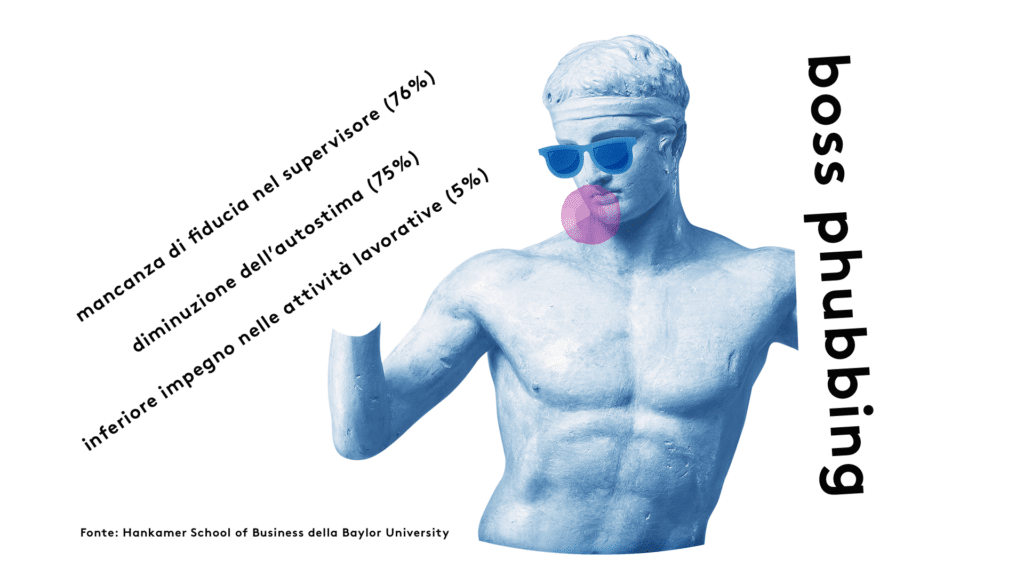We all do it, perhaps unknowingly, at home, with friends, and even at the office. When we fall victim to it, we realize how annoying it can be, but despite this, it does seem to be a temptation stronger than us: it is phubbing. But what does it consist of? Why is it harmful? And above all, how can it be avoided?
One aspect that at Performant by SCOA we always emphasize with the companies we work with is that behaviors, of whatever kind, are observable. There are some, then, that are not only observable, but even evident, in plain sight at any time of day, and among these is phubbing. The term phubbing was coined in 2012 by the University of Sydney and is the result of the crasis between the English words phone and snubbing. Over time, it has become increasingly widespread, so much so that it has now also entered the headwords of the Treccani, which defines it as ‘the action, the fact of neglecting one’s physical interlocutor to consult one’s mobile phone or other interactive devices often, more or less compulsively’.
An attitude that, according to a study by the University of Kent, precisely because it comes naturally, is now considered as ‘normative and not harmful in general’, as it meets three criteria, which are those of false consent, reciprocity, and frequency, leading individuals to consider a widely spread attitude as accepted and acceptable on a large scale. In reality, the message that gets through is that whatever notification reaches one of the two interlocutors is more important than the person in front of them.
It is the discrepancy between the perceptions of the people involved that generates, even in a company, the problem: if in the eyes of one party nothing wrong is being done, the other party perceives it as rude. This can have large negative effects on the quality of relationships and consequently on the trust, engagement, and productivity of employees.
What are the (negative) effects of phubbing?
After 2020, with the spread of smart working and the possibility of on-call meetings, going to the office in many contexts and organizations is no longer an obligation. Yet it is clear to everyone what the added value of a hybrid way of working is, of transforming the office from a place where you can be at your computer from 9 a.m. to 6 p.m. to a place where you can weave relationships, have exchanges on a more human level and be involved in what you do by creating a bond with the people you do it with.
In this context, the danger of phubbing becomes even more insidious, because it undermines the quality of being together, triggering a spiral from which it is difficult to escape. The one who carries it out (the phubber) risks starting a vicious circle in which the one who suffers it (the phubbee), annoyed and bored by the phubber’s attitude, pulls out his phone, becoming a phubber in turn: an automatic chain that generates a widespread sense of isolation and exclusion that, on the one hand, undermines everything for which the office still exists, on the other hand, at a deeper level, it creates an organizational and behavioral culture in which carelessness and a lack of listening are found daily, which then give rise to negative consequences on relationships and misunderstandings linked to loss of information, difficulties in coordination and lack of alignment on the activities to be carried out.
The aforementioned study from the University of Kent shows how phubbing significantly worsens communication and relationships between people, as it is a form of social exclusion: using the phone while someone is talking to us threatens relational human needs that are fundamental, such as belonging, self-esteem, sense of achievement and control, and in addition worsens people’s moods.
This aspect should not be underestimated, especially in the corporate context, where engagement, satisfaction, and self-esteem are very important elements for the well-being of employees.
The consequences are even worse when what researchers at Baylor University’s Hankamer School of Business define as boss phubbing occurs, i.e. a supervisor’s habit of being distracted by his or her smartphone when talking or in close contact with employees: this can be a real obstacle in building a fruitful relationship, but above all, it can undermine the professional development of the employee himself.
Research has shown that the most notable consequences on the team of boss phubbing concern:

- lack of trust in the supervisor (76%)
- decreased self-esteem and mental well-being (75%)
- lower commitment to work activities (5%)
- time & task management: not everything that comes in is urgent. Creating an environment in which workers are not obliged to respond to every message in the shortest possible time makes it easier to feel empowered to continue talking to the people in front of you rather than holing up on the phone or computer all of a sudden.
- Conflict management: it is often easier to avoid a conflict than to deal with it, and the phone is a good excuse to escape from a situation we don’t like. An urgent message, or a phone call that has to be answered, are escape routes that are always at hand. Encouraging co-workers to confront each other, and express their opinion without fear, can also be useful to prevent the use of the telephone from leaving misunderstandings hanging.
- interpersonal communication: by message, misunderstandings are more likely, while a face-to-face conversation makes people understand each other better. It is important to make people feel stimulated to talk and relate to others to be more involved in what they do, also by creating areas of the office and moments dedicated to integration and getting to know each other.
- Feedback: Constant discussion between supervisor and employee encourages confrontation and honesty, and increases mutual trust and a sense of belonging. Allowing the employee to speak freely with his or her supervisor is a way of making the supervisor understand if there are attitudes he or she implements that may be an obstacle to the employee’s professional development (such as the attitude he or she has with his or her smartphone).





